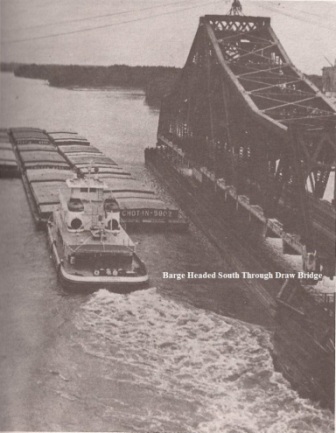Clinton's New Rail Bridge 1909
From: The Clinton Herald, February 23, 1909
Transcribed by a Clinton County IaGenWeb volunteer.
First Photograph Taken of The Northwestern’s Huge Electrical Draw.
 The Herald today presents the first picture of the great electrically driven
draw of the Chicago & Northwestern, taken since the new bridge was opened for
traffic. The picture is taken from the Iowa shore, south of the new bridge.
The Herald today presents the first picture of the great electrically driven
draw of the Chicago & Northwestern, taken since the new bridge was opened for
traffic. The picture is taken from the Iowa shore, south of the new bridge.
The draw is supported by what is called the “central octagonal” caisson pier,
the largest in the entire sub-structure of the bridge. The draw span was erected
by means of a “three bent” double rail traveler.
The draw will be moved by two 45 horse power electric motors operating the
turning mechanism and two twenty horse power motors one at each end of the draw
operating the end lifts. Power will be furnished from a power house located on
the west bank. The prime movers will be two fifty horse power two-cylinder
vertical Otto gasoline engines working either directly through electric
generators or through the latter and a Westinghouse storage battery.
The work of removing the channel spans of the old bridge is proceeding briskly
this week, and the middle of March will mark its disappearance far below the
water line.
In the meantime the new bridge will be completed.
The Clinton Daily Herald, Monday Evening, August 3, 1908
TRAIN CROSSES THE NEW BRIDGE.
Northwestern and Burlington Officials See “Q” Passenger Steam Over Steel Bridge
Across River.
That portion of the new railroad bridge of the Chicago & Northwestern railway
company across the Mississippi river, extending from the Illinois shore and
Little Rock Island, was officially opened this morning, when the first train
crossed the bridge from the island to the Illinois shore. The first train to
pass over the bridge was a Burlington passenger. Several officials of the
northwestern and Burlington roads were at the bridge this morning when the train
crossed the river.
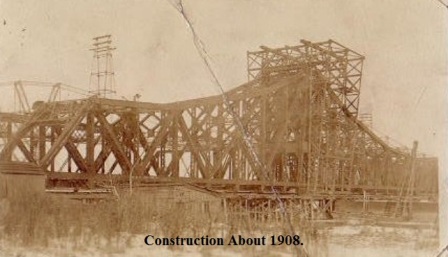 Commencing today, Burlington trains are using the south track of the new bridge
between east Clinton and the island, being switched onto the old bridge at that
point. At present the Northwestern trains will be operated over the old bridge.
After 2 o’clock next Wednesday afternoon the Burlington trains, both west and
east bound, and west bound Northwestern trains will use the south track of the
new bridge.
Commencing today, Burlington trains are using the south track of the new bridge
between east Clinton and the island, being switched onto the old bridge at that
point. At present the Northwestern trains will be operated over the old bridge.
After 2 o’clock next Wednesday afternoon the Burlington trains, both west and
east bound, and west bound Northwestern trains will use the south track of the
new bridge.
Superintendent W. D. Beck of the Galena division of the Northwestern has issued
the following bulletin relative to opening of the new bridge.
Trains of both roads will be governed eastbound by semaphore indications at West
Clinton and Little Rock Island and by hand signals at east Clinton.
Trains of both roads westbound will be governed by hand signals at East Clinton
and by Samphore signals at Little Rock Island and West Clinton.
Signalmen at East Clinton, Little Rock Island and West Clinton will handle the
switches at their respective offices, and all trains must approach these points
under absolute control and not proceed until assured that the track is clear for
them and proper signals are received.
Final change establishes a railway grade crossing about two hundred feet east of
the east bank of the Mississippi river between the C. B. & W. railway eastbound
and the main track of the C. & N. W. railway westbound. Regulation stop boards
will be erected four hundred feet from said crossing and thereafter C. B. & Q.
trains eastbound and C. & N. W. westbound will make regulation crossing stop as
per current rules and state law, not proceeding until the way is known to be
clear.
There will be no charge in present method of operation between Little Rock
Island and West Clinton other than as indicated above.
The speed of all trains passing over any portion of the old bridge at either the
east channel or draw span must not exceed five miles per hour.
The Clinton Daily Herald, Monday Evening, August 14, 1908
BRIDGE NEAR ITS COMPLETION.
Foundation Company Working on Last of the Caissons, Abutment and Stone Pier on
Iowa Side of the River.
CENTRAL CAISSON HITS A SOLID FOUNDATION.
Pressure Men Will Be Transferred to Last Caisson in a Few Days – Strange Find of
Crews Far Below Surface of the Mississippi.
The Foundation company is working on the central caisson, the pier at this
shore, and the abutment on this bank of the river; while it has gotten the last
caisson in place ready to sink. The pier, No. 29, is practically completed, and
much of the work on the abutment has been completed. The big caisson now rests
on bed rock, and the company has its big task well in hand.
The piers and abutments of the new Northwestern bridge are all numbered,
beginning at the east end of the bridge. The Iowa abutment is No. 30, there
being that number of supports under the huge structure.
Abutment Nearly Completed.
The abutment will be completed in about three days, only three courses of rock
remaining to put in.
Yesterday the “sand hogs” engaged in putting down the central octagonal caisson
struck “bed rock” i.e., the huge frame rested on the solid rock far down below
the surface of the river. In a few days the interior of the caisson will be
solidified with concrete, and the pressure will be taken off, the pneumatic men
beginning work on the last of the caissons, now in place and ready for sinking.
When this last caisson is down the sub structure of the new bridge will have
been entirely completed.
Reaching from the abutment on the Iowa shore to a point near Second street, the
company will put in a huge fill. The work of putting in this fill will be taken
up in a short time.
River Dog in Caisson.
A strange find was made one day this week by the pressure men, working in the
interior of the central caisson.
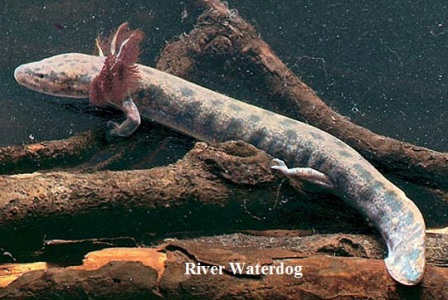 It was a water-dog, alive and evidently in a very healthy condition. The
amphibious creature, which is occasionally met with in the river hereabouts, was
found 45 feet below the river’s surface, floundering about in the soft mud in
the bottom of the caisson. It is a large specimen, nearly two feet in length,
and was brought alive to the surface.
It was a water-dog, alive and evidently in a very healthy condition. The
amphibious creature, which is occasionally met with in the river hereabouts, was
found 45 feet below the river’s surface, floundering about in the soft mud in
the bottom of the caisson. It is a large specimen, nearly two feet in length,
and was brought alive to the surface.
Just how the water dog got into the caisson is something of a mystery. Some of
the pressure men believe it had burrowed into the bottom of the river to the
depth at which it was found. Others are of the opinion that the creature was
lying in the mud when the caisson was put down, and unable to effect its escape,
managed to avoid detection as the frame was gradually forced down towards
bed-rock. In either event, its presence so far below the river bottom is strange
and inexplicable.
The water-dog is a species of lizard and is a very repulsive looking creature.
It appears to be part animal and part fish, and though very fierce looking, is
thought to be perfectly harmless.
The Clinton Daily Herald, February 14, 1909
Trains Enter Iowa Over New Double Track Steel Bridge.
 The Clintonite who has not wandered down to the river bank in the vicinity of
the bridges since last fall would scarcely know the place today, so great a
transformation has been made down there by the Chicago & Northwestern Railroad
company. A huge double-track bridge has been reared above the water, with an
electric draw of great size; tracks have been changed and elevated; a power
house constructed on the river bank; and now, a still greater change is being
brought about, by the demolition of the old bridge of the Chicago &
Northwestern, extending from Little Rock island to the Iowa shore.
The Clintonite who has not wandered down to the river bank in the vicinity of
the bridges since last fall would scarcely know the place today, so great a
transformation has been made down there by the Chicago & Northwestern Railroad
company. A huge double-track bridge has been reared above the water, with an
electric draw of great size; tracks have been changed and elevated; a power
house constructed on the river bank; and now, a still greater change is being
brought about, by the demolition of the old bridge of the Chicago &
Northwestern, extending from Little Rock island to the Iowa shore.
But great as has been the transformation wrought by the company of late, there
are still greater changes coming. These are the razing of the old depot and
freight house, and the erection of splendid new buildings on their sites; and
perhaps the destruction of the old roundhouse and shops, and the installation of
a fine park system there to beautify that portion of the city. Verily, the great
railroad company is working wonders in Clinton.
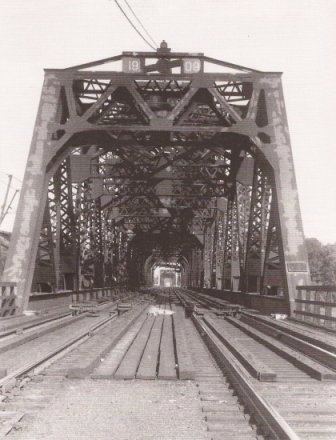 The Herald has devoted many columns to that enterprise which has aroused so much
interest among the people of Clinton, the building of the giant new bridge, over
which trains of the company are now entering Iowa and the west. It has tried to
keep its readers informed on the progress of the work, since the first pile was
driven over on the far side of the island. This week marks the practical
culmination of the project, though much work remains to be done; for trains
commenced to regularly operate across the bridge yesterday, at 8:50 o’clock in
the morning. Ten minutes later the work of removing the island spans of the old
bridge commenced, and this work is now well under way. Thus a historic old river
mark will soon be a thing of the past.
The Herald has devoted many columns to that enterprise which has aroused so much
interest among the people of Clinton, the building of the giant new bridge, over
which trains of the company are now entering Iowa and the west. It has tried to
keep its readers informed on the progress of the work, since the first pile was
driven over on the far side of the island. This week marks the practical
culmination of the project, though much work remains to be done; for trains
commenced to regularly operate across the bridge yesterday, at 8:50 o’clock in
the morning. Ten minutes later the work of removing the island spans of the old
bridge commenced, and this work is now well under way. Thus a historic old river
mark will soon be a thing of the past.
Accompanying are presented views of the new bridge in various stages of its
construction, which are of especial interest at this time.
About the Old Bridge.
In the year 1858 the Chicago, Iowa & Nebraska Railroad company began the
construction of a bridge at Clinton, Iowa, from the east bank of the river. In
1859 the bridge was completed as far as Little Rock island, and connected with
the Chicago & Galena union railway, a line along the east bank of the river, to
Fulton, Ill. A car-ferry was operated from Little Rock island to the Iowa shore.
In the year 1864 the west channel was bridged, completing the second railroad
bridge across the Mississippi. W. D. Walden, the popular superintendent of the
Clinton bridge, was foreman of carpenter work in the construction of this
bridge.
The draw was rebuilt in 1887, and many alterations, improvements and
strengthening measures subsequently taken which became necessary by reason of
the consequently increasing traffic.
The New Bridge.
 The Herald, in its annual edition of 1908, printed a complete of eh new bridge.
The Herald, in its annual edition of 1908, printed a complete of eh new bridge.
As early as the year 1900 the company had seriously considered the construction
of a new bridge across the Mississippi. A constantly increasing traffic,
amounting at times to 150 or more train movements in a day, making a new bridge
almost a necessity; while the condition of the old bridge forced a reduction in
speed on the part of trains crossing the structure. Surveys and borings for a
new double-track structure were made in 1901.
A congressional act of February 6, 1907, authorized the construction of the
bridge, and on May 4th of the same year the secretary of war approved the plans
for the bridge.
The vice president of construction issued a formal order authorizing the
necessary expenditures for the bridge on March 21, 1907. A contract for the
entire sub-structure was entered into on May 18, 1907, and in the same year a
contract was made for erection of the slough spans and east channel spans.
Contract for erecting the west channel spans was made in February, 1908.
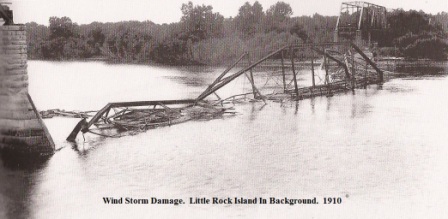 Briefly stated, the above were the preliminaries in the great project which is
now being completed. The bridge is founded on solid rock, far below the river’s
bottom, and is a triumph of modern engineering skill. Its construction has been
in charge of F. H. Bainbridge, an engineer of wide experience in similar great
enterprises.
Briefly stated, the above were the preliminaries in the great project which is
now being completed. The bridge is founded on solid rock, far below the river’s
bottom, and is a triumph of modern engineering skill. Its construction has been
in charge of F. H. Bainbridge, an engineer of wide experience in similar great
enterprises.
Rearranging the Tracks.
A long fill has been put in, leading from the bridge to the depot, and at
present the work of rearranging the tracks is under way. A big crew of men is
engaged in this work. The process is simple but effective. The rails, ties and
bolts are moved bodily by the crews, who are equipped with heavy bars of steel.
Some 40 or 50 men, grouped closely together, and standing between the ties,
insert their bars under the track. At a signal from the spokesman they put their
united strength to the bars, and the track moves a few inches. This process is
repeated incessantly, and the loud “Yo! Yo! Yo!” of the spokesman (selected out
of the whole crew by reason of his superior vocal abilities) may be heard two or
three blocks away.
The bridge dispatcher’s office has been temporarily moved to a location near the
west end of the bridge. The east Clinton interlocking plant is now in operation,
and during the coming spring the electrical plant at this end of the bridge will
be constructed.
The Clinton Herald, October 25, 1958, P.1
Bridge Fire Damage May Hit $1-Million.
Halt River, Rail Traffic.
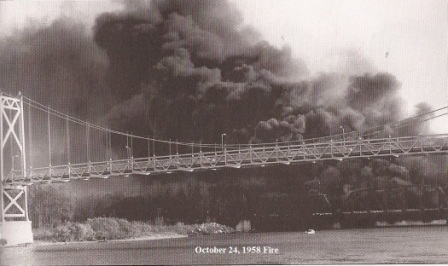 Damage which may total a million dollars and a tie up of river and east-west
rail traffic at Clinton is the result of a spectacular fire Friday afternoon on
the Chicago and North Western railroad drawbridge.
Damage which may total a million dollars and a tie up of river and east-west
rail traffic at Clinton is the result of a spectacular fire Friday afternoon on
the Chicago and North Western railroad drawbridge.
The fire which is believed to have started from a workman’s acetylene or welding
torch, spread rapidly from tie to tie and sped across the plank decking of the
410-foot span in a matter of minutes.
North Western railway officials said today the minimum damage to the 50-year-old
bridge would be “several thousand dollars”.
If the superstructure of the heavy span is damaged, the loss may run as high as
a million dollars, an unofficial spokesman said today.
Meanwhile, river traffic has been halted by the U. S. Rock Island engineering
district.
Opening mechanism of the bridge is said to be hopelessly damaged. If the span
can not be opened today by manual controls, the river tie-up will be complete
unless emergency measures are ordered by the district engineers.
River tows were halted at Bellevue and Bettendorf last night, but several tows
pushing a score of barges, most of them empties, are in the “bottleneck” and are
tied up along Riverview park.
The fire reportedly broke out near the west end about 2 p.m., and was fought by
workmen with fire extinguishers for nearly an hour before it raged out of
control. A call was put in to the Clinton fire department at 2:50 p. m.
By the time the first fire equipment was at the scene, the west sheer boom (the
long frame work structure bordering the main channel) was blazing fiercely.
In a matter of minutes, the flames had reached the bridge planking and ties, and
fed by the heavy creosote with which the lumber is treated, and fanned by a
stiff 25-mile-an-hour wind, sped from tie to tie until over 200 feet of the
bridge floor was ablaze.
As the fire raged, it sent towers of billowing black smoke hundreds of feet into
the air in a dark tower which could be seen for miles.
 The blaze attracted hundreds of spectators, which swelled to thousands before
the four-hour battle was over. Capt. Stewart Kraus, in charge of the Central
station while Fire Chief Harold Nelson is on vacation, said the fire was brought
under control by 4 p. m. but stubbornly smoldering pilings kept the men on the
job until nearly 8 p. m.
The blaze attracted hundreds of spectators, which swelled to thousands before
the four-hour battle was over. Capt. Stewart Kraus, in charge of the Central
station while Fire Chief Harold Nelson is on vacation, said the fire was brought
under control by 4 p. m. but stubbornly smoldering pilings kept the men on the
job until nearly 8 p. m.
Fulton Fire Chief Floyd Van Dellen and 10 volunteer firemen from the Fulton Fire
Protection district, fought the fire from the Illinois side of the bridge.
The Fulton squad got the fire under control at its most eastern point and then
worked across the span toward the Clinton department which was fighting the
blaze, tie by tie, from the west end. The Fulton department remained to assist
in some clean up work before leaving about 6 p. m.
Clinton police also did yeoman work during the fire, assisting in keeping back
the hundreds of spectators, aiding in keeping fire equipment moving, keeping
hose lines clear, and lending a hand to firemen when needed.
Over a mile of hose was laid in two lines extending from hydrant connections at
2nd St. and 8th Ave. S. and at 10th Ave. S.
Chief Nelson, though officially on vacation, was at the scene and was reported
to be the only casualty. Nelson received a badly skinned shin when his foot
slipped through two water-soaked ties.
One hose line was left connected and was put in use during the night, when
railroad crews already started on repair work, reported a fire had again broken
out in the piling. A fireman was dispatched to turn on the water and the blaze
was brought under control within a short time.
Unexpected help came shortly after 5 p. m. when one of two marooned barges came
to the rescue. Capt. George C. Thorpe anchored his tow of empty barges at
Riverview park and brought the Suffolk down to the bridge to aim its fire
fighting equipment at the burning ties from underneath.
Thousands of spectators, drawn by the clouds of smoke and shrieking sirens of
police and fire vehicles, came to the scene, and lined the railings of the
Gateway bridge where slow moving vehicles caused several traffic jams.
No statement was available this morning from railroad officials, but numerous
department heads are checking on possible damage to the superstructure. Chicago
office executives were reported last night to be due here by plane.
Visible this morning are the badly warped steel rails which are already being
removed, and the charred flooring and ties across the entire span. A drag line
was maneuvered into place this morning to begin clean-up work.
Meanwhile four tows of 37 barges, about half of them with cargo, are “stacked
up” between Lock 13 and the drawbridge.
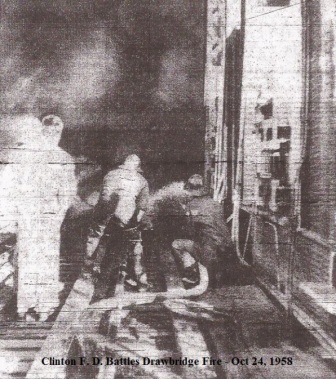 Robert Clevenstine, chief of operations of the U. S. Engineers Rock Island
district, said today that until an official report is received from the
railroad, no action will be taken on moving river traffic. If the bridge is
totally inoperable, he said, the marooned barges probably will have to be
“shuttled through” and picked up below the bridge by tows sent north by the
owners.
Robert Clevenstine, chief of operations of the U. S. Engineers Rock Island
district, said today that until an official report is received from the
railroad, no action will be taken on moving river traffic. If the bridge is
totally inoperable, he said, the marooned barges probably will have to be
“shuttled through” and picked up below the bridge by tows sent north by the
owners.
Capt. Thorpe of the Suffolk, whose tow is made up of empty crude oil barges,
asked police and firemen to warn the public to stay at a safe distance from the
barges because of the danger of fire, or other accident.
At the height of the fire last night, several small boats maneuvered dangerously
close to the fire area and several passed under the burning bridge, apparently
unaware of the danger of the falling ties and flying embers.
Firemen extended their thanks today, however to the numerous other small boat
owners who stood by, ready for rescue operations if an emergency arose.
Men of fire Companies 1, 4 and 2, and all off duty men who had been called in,
started last night and are continuing today, on the arduous task of scrubbing
and drying the 5,350 feet of hose which were used. Able assistance was given by
men of the 4-11 auxiliary fireman squad.
The Coast Guard cutter Fern arrived at the scene shortly after 7 a. m. today and
was at work placing markers and buoys, above and below the bridge as the river
version of “Road Closed.”
North Western veterans say this is the first serious tie up on the drawbridge
since it was opened in 1909. An interested spectator at the fire yesterday was
Charles M. Kohler, about 85, of 828 5th Ave. N., the last survivor of the crew
which installed the bridge planking.
Kohler said he helped open the bridge for the first time in 1909, when crowbars
were used to pry the new draw open for the “Minnie Schneider,” transporting a
load of sand and gravel.
The Clinton Herald, October 25, 1958, P.10
Span Fire Snags Mail Shipments; Future Uncertain.
The North Western drawbridge fire here Friday afternoon caused “some delay” in
incoming and outgoing mail last evening and early today, according to the
Clinton post office, since no facilities were available to handle bulky items,
such as parcel post.
The Clinton post office said some outgoing mail was transported by government
truck around 6:30 last evening across the Gateway bridge where a railway car was
spotted on the Illinois side.
Postal officials said plans for local mail-handling hinge largely on decisions
to be made soon by the North Western; for example, whether mail might be
rerouted via Savanna, Ill., or the Quad Cities.
The Clinton Herald, October 25, 1958, P.10
Timing of Blaze Thrill to Pupils, Worry to Moms.
Start of the spectacular fire at the North Western drawbridge was “timed” almost
perfectly with the dismissal of Clinton school children Friday afternoon.
That sort of a concurrence is either and exciting thing or an exasperating turn
of events, depending on whether you’re pupil or parent.
Word spread like wildfire that the billows of smoke seen against the eastern sky
in mid-afternoon were the result of a huge blaze at the half-century-old
drawbridge. Students with bikes wasted no time getting down to the scene of the
fire at the river banks.
Around supper time, quite a few mothers showed up at the bridge area to see if
they could “encourage” their offspring to show up at home for supper.
One zealous young fire fan was so wrapped up in the spectacle that he or she
left a bike at the riverfront. It was reported by bridge officials to Clinton
police and taken to the station around midnight.
The Clinton Herald, October 28, 1958, P.8
Bridge Repair Progresses; No Estimates on Fire Damage.
While engineers are still probing for evidence of fire damage, North Western
railway officials today reported “good progress” on the repairs which are being
made to the Mississippi river drawbridge which was extensively damaged by fire
Friday afternoon.
A spokesman who asked to remain unidentified, said as yet no estimates can be
made on the cost of repair.
A new track is being laid on the north (eastbound) side of the 400-foot span,
but the official declined to comment on when the track would be ready for use.
Steelworkers and engineers are still working on the superstructure to determine
if there is any fire damage, he added.
Questioned as to the possibility of opening the drawbridge, the officials said
“there are none.” Another spokesman had told a Herald reporter Monday an attempt
would be made late that afternoon to open the draw. However, unofficial sources
now say the draw span has expanded several inches due to the intense heat of the
ire, and its early opening would be “an impossibility.”
 Meanwhile, river tow boats are shuttling their cargo laden barges under the
bridge, which is high enough to permit the passage of barges, but not enough to
accommodate most of the tow boats. Unless the draw is opened soon, some of these
tow boats may be “wintered in” above Clinton, as only a few weeks of navigation
remains.
Meanwhile, river tow boats are shuttling their cargo laden barges under the
bridge, which is high enough to permit the passage of barges, but not enough to
accommodate most of the tow boats. Unless the draw is opened soon, some of these
tow boats may be “wintered in” above Clinton, as only a few weeks of navigation
remains.
Freight and passenger traffic is being rerouted via detours on Milwaukee and
Burlington rail road lines.



